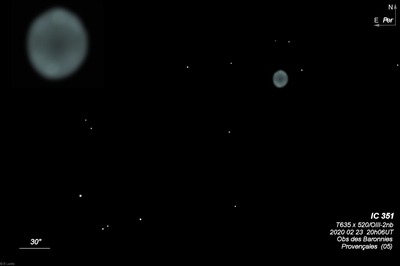
E.E. Barnard discovered IC 351 on 5 Dec 1890 with the 36-inch refractor at Lick Observatory, while examining the region near Comet Zona. He estimated a diameter of 4.6" and a magnitude of 10.5-11. Sherburne Burnham measured a diameter of 10".
Based on a Crossley photographs, Curtis (1918) described, "central star can be made out and is perhaps as bright as mag 14. The nebula shows a minute elliptical disk, which is 8"x6" in PA 10° in a 5 minute exposure. An elongated brighter patch is in the center."
200/250mm - 8" (12/4/80): fairly faint, very small, slightly elongated SW-NE. A wide trio of stars is about 3.5' SE consisting of mag 9 SAO 56707, a mag 10.5 star and a mag 12.5 star (separations of 32", 36" and 58").
400/500mm - 17.5" (3/1/03): swept up at 100x as a fuzzy mag 12 "star". Nice view at 380x, which reveals a moderate surface brightness 7" disk. Fairly evenly illuminated but the halo has a slightly irregular surface brightness. A mag 15 star is 20" WNW of center with a slightly fainter star further north. Located 3.4' NW of mag 9.5 SAO 56707. A mag 11 and 13 stars complete a trio to the SE.
17.5" (1/8/00): picked up at 100x as an out of focus mag 11 "star". At 220x, this high surface brightness PN was clearly nonstellar and slightly oval with a hint of a sparkle (central star) at the center. At 500x, appeared as a small, well-defined disc, elongated 4:3 SW-NE with dimensions ~7"x5". The quasi-stellar center was brighter with a small, fainter halo that seemed irregular. A couple of faint stars are close west and north. Located 3.5' NW of a distinctive trio of mag 10/11/13 stars.
Notes by Steve Gottlieb